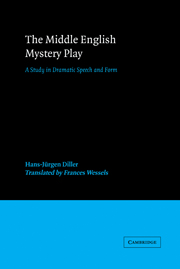Book contents
- Frontmatter
- Contents
- Preface
- Note on texts used
- Abbreviations and special symbols
- Introduction
- Part I The foil: Latin church drama
- Part II The English Creation to Doom cycle
- 5 The origins of the Creation to Doom cycle and its stage
- 6 The representation of time and space in the cycles
- 7 Address to the audience
- 8 Intra-dramatic speeches
- 9 Conclusions
- Notes
- Bibliography
- Indexes
6 - The representation of time and space in the cycles
Published online by Cambridge University Press: 04 March 2010
- Frontmatter
- Contents
- Preface
- Note on texts used
- Abbreviations and special symbols
- Introduction
- Part I The foil: Latin church drama
- Part II The English Creation to Doom cycle
- 5 The origins of the Creation to Doom cycle and its stage
- 6 The representation of time and space in the cycles
- 7 Address to the audience
- 8 Intra-dramatic speeches
- 9 Conclusions
- Notes
- Bibliography
- Indexes
Summary
Sketch of a typology
Before the four cycles are discussed individually a few general remarks will be useful. The treatment of Second World time and space on the stage must face special problems whenever the events of a story are distributed over more than one (usually two) localities. We can distinguish two basic techniques, which I shall call the technique of ‘continuous correspondence’ and the ‘cutting’ technique (using a term borrowed from the movies). ‘Continuous correspondence’ demands that after a person's departure from place A his travel to place B be represented on stage. ‘Cutting’ means that the journey is ‘cut out’ and that the dialogue either continues at place A after the person's departure for some time or ‘cuts’ to place B immediately. ‘Cutting’ and ‘continuous correspondence’ can be contrasted as in Figure 1 (optional stages are enclosed in interrupted lines).
Continuous correspondence is a technique which suggests itself immediately when a narrative source has to be put on stage. The sentence ‘The messenger went from A to B’, simple enough in narrative, becomes somewhat awkward when translated to the stage. The itinerant's uneventful journey will either have to be filled with otiose material (often with songs), or the discrepancy between Second World and First World distances will become very apparent to the audience. The ‘cutting’ technique shows a better understanding of the requirements of the stage and betrays a greater degree of independence from the narrative source. It seems justified, therefore, to call the technique of continuous correspondence ‘primitive’ and the ‘cutting’ technique more ‘sophisticated’ or ‘advanced’. At the same time it ought to be understood that these adjectives do not imply any value judgment.
- Type
- Chapter
- Information
- The Middle English Mystery PlayA Study in Dramatic Speech and Form, pp. 79 - 108Publisher: Cambridge University PressPrint publication year: 1992



